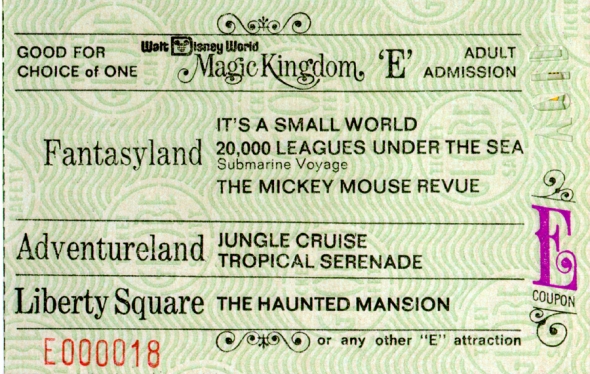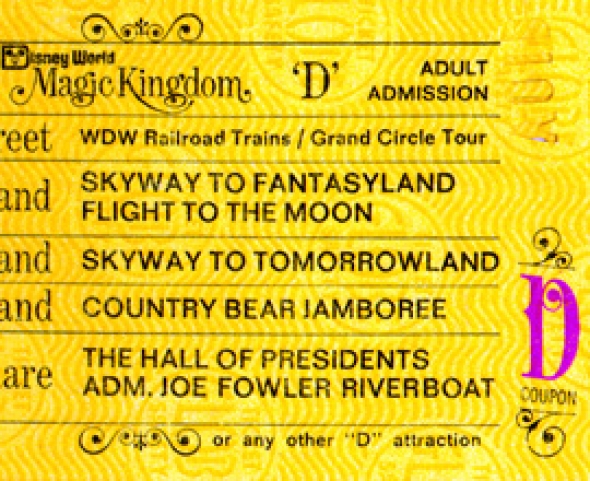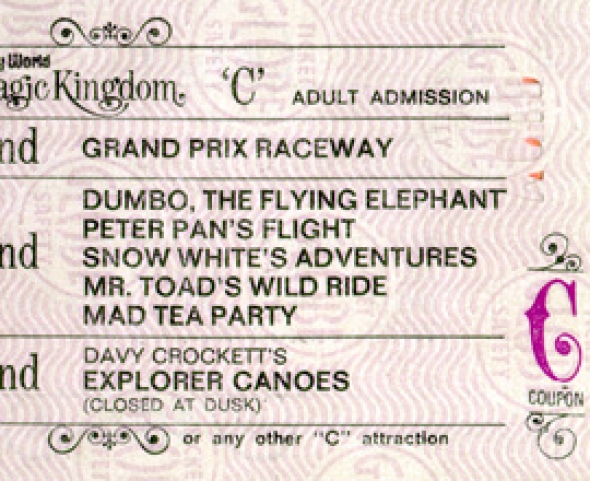The arrival of the E ticket
Image: DisneyPark planners rolled out the E ticket in combination with the new attractions. At the same time, they upgraded several previous D ticket attractions to the top tier. Those eight were Jungle Cruise, Mark Twain Riverboat, Rafts to Tom Sawyer Island, Rainbow Mountain Stage Coaches, Rainbow Ridge Pack Mules, Rocket to the Moon, Sailing Ship Columbia, and Santa Fe & Disneyland Railroad. Guests in June of 1959 arrived at Disneyland to discover a grand total of 11 attractions that required a kind of ticket that previous Value Books didn’t have.
Think of the situation in modern terms. When Disney adds a new park expansion, prices naturally rise. The corporation must pay for this new area. Today, merchandise and food revenue goes a long way, but that business model was immature in the late 1950s. Disney needed guests to pay for their rides. They charged more for their revolutionary new attractions.
This price rise was dramatic, too. When E ticket debuted in 1959, A ticket attractions had a value of 10 cents each, the equivalent of 87 cents today. For B tickets, their cash value was 15 cents ($1.30 today), while C tickets were 25 cents ($2.17).
Image: DisneyD tickets are the most important discussion. Disney effectively added an entirely new tier in 1959. The previous tier, D tickets, had been the most expensive at 50 cents ($4.33 today). E tickets were 85 cents on day one ($7.36 now). That’s a 70 percent increase in prices, which seems stiff but understandable for the three new attractions. It was hefty inflation for the other eight rides, though. They’d cost 35 cents less the previous month.
Let’s think about that in simplest terms. In a single month, Disney raised the rates on those eight rides by the same cost as an A and B ticket combined. In that way, the company set the standard for all of its future expansions. They trained customers that all new additions (i.e. standard Disney plussing) would come at a cost. And Disney would pass that cost along to theme park tourists. In a way, that’s the main legacy of the E ticket.
The end of the E ticket
Image: DisneyYou still hear the term E ticket referenced today. Whenever Disney announces a new ride, they’ll trumpet its greatness by describing it as an E ticket attraction. They do this despite the fact that the term is no longer applicable. The company wants to distinguish its highest quality attractions from the rest.
A recent example occurred at Pandora – The World of Avatar, where Avatar Flight of Passage received the E ticket designation while Na’vi River Journey did not. As the themed land’s opening day approached, Disney had to perform a bit of PR spin to assure fans that Na’vi River Journey was good, too. Their conditioning of guests to perceive anything less than an E ticket attraction worked against them in hyping an expensive new ride.
The stunning aspect of the E ticket is how pervasive the term is in our culture even today. It’s remained a part of the pop culture zeitgeist despite the fact that Disneyland last used ticket books in 1982. During that year, the Happiest Place on Earth transitioned to single-price park admission.
Image: DisneyRather than pay per attraction, guests purchased an admission ticket that entitled them to usage of everything at Disneyland. It’s the system that’s still in place more than 35 years later, but the idea of the E ticket still exists.
Amusingly, the reason why it’s no longer a practical business practice has little to do with Disney. Instead, a competing park in the area, Six Flags: Magic Mountain, offered a single-admission, ride-everything ticket. Starting in 1981, Disney tested their own version as they felt compelled to follow suit. Within a year, park planners accepted the streamlined business model as superior to the messy one of ticket books.
Image: DisneyThe change felt dramatic at the time. After all, Value Books were so established that Magic Kingdom adopted this strategy during its 1971 opening. They wouldn’t ditch it until the opening of Epcot in 1982. In the interim, Magic Kingdom listed eight E Ticket attractions. Strangely, these tickets were interchangeable at Disneyland, meaning that you could purchase an E Ticket book in Orlando but ride Jungle Cruise in Anaheim instead.
Oddities such as these in combination with the heightened competition from theme park imitators explains why Disney eventually eschewed E tickets despite the powerful name recognition of that concept, one that remains to this day.





Add new comment